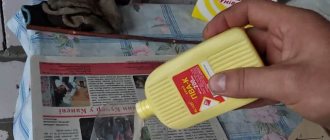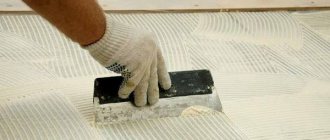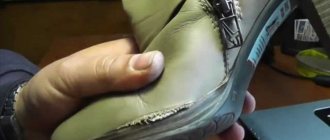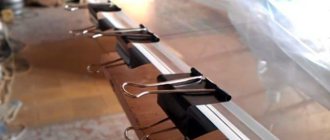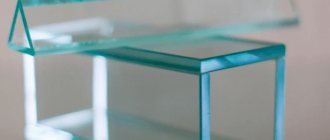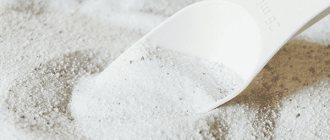When constructing structures made of foam concrete, specialists use special glue. It is a special dry mixture consisting of Portland cement, fractionated sand and technical additives.
Below we will look at how to use such compositions, and also find out how much glue for foam blocks costs.
Bag of dry adhesive mixture
Cement base or glue
For masonry, you can use both glue and classic cement composition. A realistic assessment of the construction process will help you make a choice. If foam concrete modules are non-standard in size or have an unusual shape, preference should be given to a cement-based solution.
It is better to use professional glue in the following situations:
- Sufficient experience and skill level of the construction team.
- Foam concrete blocks having strictly regulated sizes and shapes.
The special glue is free of impurities and various additives that can cause sediment to appear. The only permissible component (mandatory for use) is fine sand, and to improve the degree of adhesion, polymers and plasticizers are introduced into the solution.
Masonry process
First of all, it is worth noting that when working with foam blocks, the first row is always placed on cement mortar, in order to avoid various (certainly possible) unevenness of the foundation, and glue is used from the second row.
During the laying process, if you are working with ordinary, standard blocks, then glue must be applied not only to the horizontal edges, but also to the vertical ones. In the case of using blocks with a tongue-and-groove connection, applying an adhesive solution to the vertical ends is optional, if not necessary.
Naturally, it is also best to prepare the blocks themselves immediately before laying, cleaning them from dust and possible fine dirt so that the glue is applied to an absolutely clean surface.
Advantages of adhesive for foam blocks
Carrying out repair and construction work with your own hands requires a detailed approach to the choice of consumables. This rule applies to both main blocks, modules, slats, and fixing compounds.
The quality of the fixative used will determine the duration of operation of the building, tightness, and heat retention in the room.
The positive characteristics of adhesive for foam blocks include:
- The presence of sand (mostly of a minimal size) makes it possible to reduce the thickness of the applied layer. Thus, the master manages to save consumables.
- Thanks to its special elasticity and viscosity, the adhesive is evenly distributed over the surface of the foam concrete modules, covering all irregularities, recesses, and the smallest chips.
- Optimal water consumption for diluting the adhesive composition.
- Not only foam concrete blocks, but also the adhesive solution itself retains heat perfectly. Thanks to two components, home owners can significantly reduce residential heating costs.
- Many craftsmen especially highlight the high degree of adhesion of the glue to the surfaces being treated.
- After complete hardening, the fixing coating is resistant to moisture, salts, abrasives, and sudden temperature changes.
- There is absolutely no shrinkage of the material, even during everyday use.
The advantages of practical choice of material also include simple rules of use.
Even the most inexperienced craftsman will understand how to lay foam blocks on glue with his own hands, how to make beautiful seams, and how to fix the modules in one position.
You can dilute the adhesive according to the attached instructions, observing the recommended proportions of the main components.
Composition and characteristics
The composition of any adhesive solution for blocks includes the following components: cement, special glue, additives, high quality fillers that improve characteristics. It is sold in a dry standard 25 kg bag. It also contains additives and moisture-retaining components to protect against excess moisture and mold formation. Special additives make the seams plastic, which eliminates the deformation of the masonry due to sudden temperature changes. To protect against frost, additives are added to the adhesive mixture, which allows construction work to be carried out in winter.
Return to contents
Types of glue for foam blocks
No composition used in construction can have universal properties and characteristics. This rule also applies to construction adhesive for foam concrete blocks.
Depending on the recommended temperature for using the material, the following types of glue are distinguished:
- Summer option. Such solutions should only be used at ambient temperatures of 5 degrees or higher. The classic composition necessarily includes white cement. After dilution and stirring, the solution must be used within 2 hours.
- Frost-resistant adhesive for foam blocks. To carry out construction work in the autumn (or warm winter), you can choose an adhesive to which antifreeze and gray cement are added under production conditions.
Due to its unique composition, the second type of glue is popular among craftsmen. However, after dilution and stirring, the adhesive composition retains its properties for 30-35 minutes.
Proportions for preparing the solution
Basically, professional builders always know what proportions of the components are needed for a certain amount of mixture, but if suddenly you are just starting to be interested in this topic, you can always find a “recipe” for preparing a solution using a bag with the composition.
The rules for preparing the mixture will also be located there. But if for some reason they were not there, then it is worth noting that they are quite simple and will be accessible to absolutely everyone:
- pour the contents of the bag (approximately 25 kg) into a clean container;
- pour in about seven to eight liters of water;
- using a drill mixer, mix the mixture at low rotation speed, bringing the solution to a homogeneous state;
- After five minutes of “ripening” the solution, it can be used.
This is what the standard preparation instructions look like, and checking the plasticity of the mixture will be quite simple; you just need to apply it with a spatula to the surface of the block and see if it spreads. When the glue thickens, you can always stir it with a mixer, but you still shouldn’t leave the mixture unused for more than 2 hours.
It will also be important to note, as already written above, that the technology for preparing glue from the winter composition differs quite a bit from the main one as follows:
- the water must be hot (at least 60 degrees Celsius);
- the temperature of the finished working mixture should not fall below +10 degrees;
- the “life” of such a solution at sub-zero temperatures is no more than half an hour;
- Never apply glue to blocks covered with frost, hoarfrost or snow.
Adhesive consumption for foam block
The only disadvantage of using foam concrete blocks is the high cost of the material. It is for this reason that the home owner or craftsman needs to calculate in advance the expected consumption of glue for foam blocks.
This parameter is quite variable and depends on the following factors:
- The thickness of the glue that the master applies to the underlying surface. A classic example and recommended standard is a thickness of 0.3 cm. However, these indicators are excellent only for perfectly smooth foam concrete modules. In the presence of grooves, chips, gross defects, for non-standard block shapes, the thickness of the applied layer increases (sometimes up to 0.6 cm).
- The presence and type of tool with which the adhesive is applied. In practice, craftsmen can cope with the task with the means at hand, however, a professional tool significantly reduces glue consumption.
- The total number of blocks used in construction.
- Qualitative composition of building modules, condition of their surface.
- An important role is played by the ambient temperature and the correct adhesive for the job (winter or summer version of the product).
The degree of qualification of the master is of great importance. Having experience and dexterity allows you to distribute the adhesive composition as evenly as possible over the surface of the blocks, without unnecessary losses.
Application method
Correct distribution of glue on foam blocks.
Before application, it is important to properly prepare the composition. To do this you will need a container and a mixing tool. You need to cook strictly according to the instructions indicated on the package in order to achieve the correct consistency and strength of the structure. A special notched trowel is required for application. First, apply the adhesive solution evenly to the side and top surface of the block, and then level it with a tool. The remaining adhesive, which was removed with a spatula, is mixed with the solution in the container and applied again. This method of application will help to use adhesive solutions sparingly, adjust the thickness of the adhesive layer, and also allow the solution to adhere well between the blocks.
Return to contents
Rating of glue manufacturers (TOP-best)
A mistake in choosing a manufacturing company can cost home owners significant financial losses. Low-quality types of glue may use coarse sand, poor modifiers, or may contain impurities.
The most popular and recognized leaders in manufacturers of adhesives for foam concrete blocks are:
- Knauf. This company produces glue that contains gypsum chips and various polymers. The crumb increases the degree of adhesion and reduces the thickness of the applied layer. Polymers give the composition viscosity and sufficient thickness.
- Titanium is another very well-known type of adhesive used in construction. On the market you can find containers with a volume of 0.75 liters, which is very convenient for use in everyday life. This type of glue is characterized by a high drying speed, as well as noticeable strength of the material.
Among the winter options for fixing compositions, Ceresite should be highlighted, which has special plasticity and resistance to external factors.
Which adhesive for foam blocks is better is up to the owner or craftsman to decide personally.


